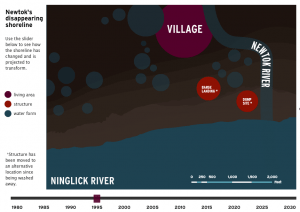 Journalists are notorious for hating anything to do with math. If we’d been any good with numbers, I often joke, we might have chosen a different career. But it’s essential for today’s journalists to get comfortable working with data, and the good news is that more and more of them are. What’s changed?
Journalists are notorious for hating anything to do with math. If we’d been any good with numbers, I often joke, we might have chosen a different career. But it’s essential for today’s journalists to get comfortable working with data, and the good news is that more and more of them are. What’s changed?
For one thing, what used to be drudgery is now a snap. I can’t remember the formula for percentage change, for example, but I can calculate it in seconds with this online tool. It’s also much easier to get your hands on data than it used to be. Carry a thumb drive everywhere and you’ll find people willing to hand over data sets that might have taken months to get otherwise. And as Simon Rogers of the Guardian’s Datablog points out, some of the biggest stories lately have been based on data.
There’s nothing that makes journalists sit up and take notice like other people getting stories. I’m noticing lots of young reporters really taking an interest in this area now. Can you imagine a reporter not using the internet now? That’s what it’ll be like for reporters who can’t be bothered to learn to use a spreadsheet.
In an Q&A with the new Datajournalism blog, Rogers says you don’t need programming skills to work with data because there are so many free and simple tools available, like Many Eyes and Googledocs gadgets. But you do need computer skills and the ability to work with statistics. Rogers’ top five tips for working with data.
- Make it manageable. Break the data down into chunks you can use.
- Keep it simple. Ask simple questions of the data and try not to get too complicated.
- Mash it up. Some of the best data journalism is about joining datasets together you wouldn’t have thought of.
- Don’t be scared of the number – or trust it too willingly. Journalists are often terrified of numbers to the extent that they don’t question them properly.
- Try not to go native. Remember you’re a journalist and your mission is to explain the data and interrogate it properly.
I’d add one more: Get inspired. Search for great examples of data journalism, like those Rogers recommends at his paper, the New York Times and the Texas Tribune. Then see what you can do on your own using free tools like the ones I’ve written about at the Yale Forum on Climate Change & the Media. Here’s a quick introduction to one of the simplest tools: Google Maps.
I’ll put more how-to videos up on my YouTube channel in the near future, so stay tuned. And in the meantime, dig in and make some data visual.









4 Comments
[…] This post was mentioned on Twitter by Steve Buttry and Stephanie Spiro, Mediagazer. Mediagazer said: Why journalists should learn to love data (@tvnewslab / NewsLab) http://j.mp/fnWqAC http://mgzr.us/BCFI […]
[…] Why journalists should learn to love data | NewsLab – I am not sharing this for the primary topic, but for the small tutorial on how to create Google Maps from raw data you might have anywhere. […]